brake KIA OPTIMA HYBRID 2015 Owners Manual
[x] Cancel search | Manufacturer: KIA, Model Year: 2015, Model line: OPTIMA HYBRID, Model: KIA OPTIMA HYBRID 2015Pages: 495, PDF Size: 13.38 MB
Page 6 of 495
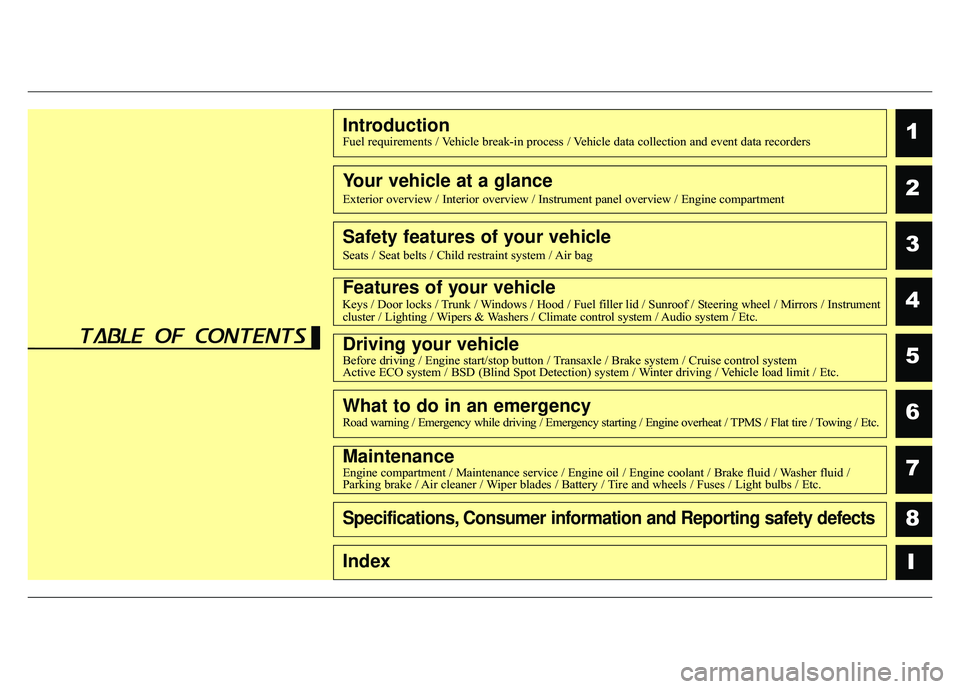
1
2
3
4
5
6
7
8I
IntroductionFuel requirements / Vehicle break-in process / Vehicle data collection and event data recorders
Your vehicle at a glance
Exterior overview / Interior overview / Instrument panel overview / Engi\
ne compartment
Safety features of your vehicle
Seats / Seat belts / Child restraint system / Air bag
Features of your vehicleKeys / Door locks / Trunk / Windows / Hood / Fuel filler lid / Sunroof / Steering wheel / Mirrors / Instrumentcluster / Lighting / Wipers & Washers / Climate control system / Audio system / Etc.
Driving your vehicleBefore driving / Engine start/stop button / Transaxle / Brake system / Cruise control system
Active ECO system / BSD (Blind Spot Detection) system / Winter driving / Vehicle load limit / Etc.
What to do in an emergencyRoad warning / Emergency while driving / Emergency starting / Engine overheat / TPMS / Flat tire / Towing / Etc.
MaintenanceEngine compartment / Maintenance service / Engine oil / Engine coolant /\
Brake fluid / Washer fluid /
Parking brake / Air cleaner / Wiper blades / Battery / Tire and wheels / Fuses / Light bulbs / Etc.
Specifications, Consumer information and Reporting safety defects
Index
table of contents
Page 11 of 495
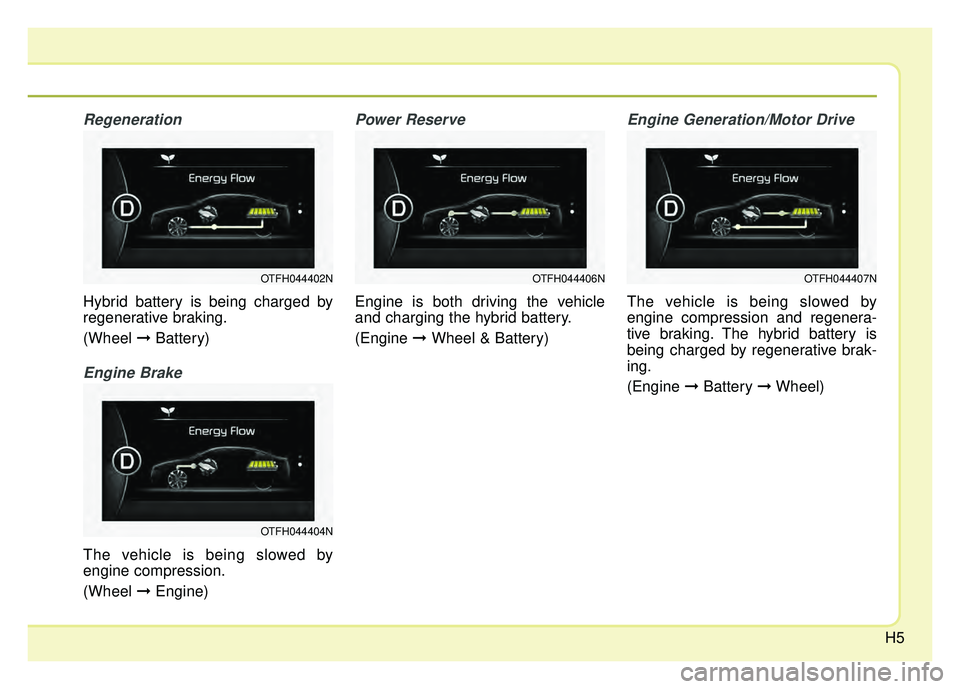
H5
Regeneration
Hybrid battery is being charged by
regenerative braking.
(Wheel ➞Battery)
Engine Brake
The vehicle is being slowed by
engine compression.
(Wheel ➞Engine)
Power Reserve
Engine is both driving the vehicle
and charging the hybrid battery.
(Engine ➞ Wheel & Battery)
Engine Generation/Motor Drive
The vehicle is being slowed by
engine compression and regenera-
tive braking. The hybrid battery is
being charged by regenerative brak-
ing.
(Engine ➞Battery ➞Wheel)
OTFH044404N
OTFH044407NOTFH044406NOTFH044402N
Page 12 of 495
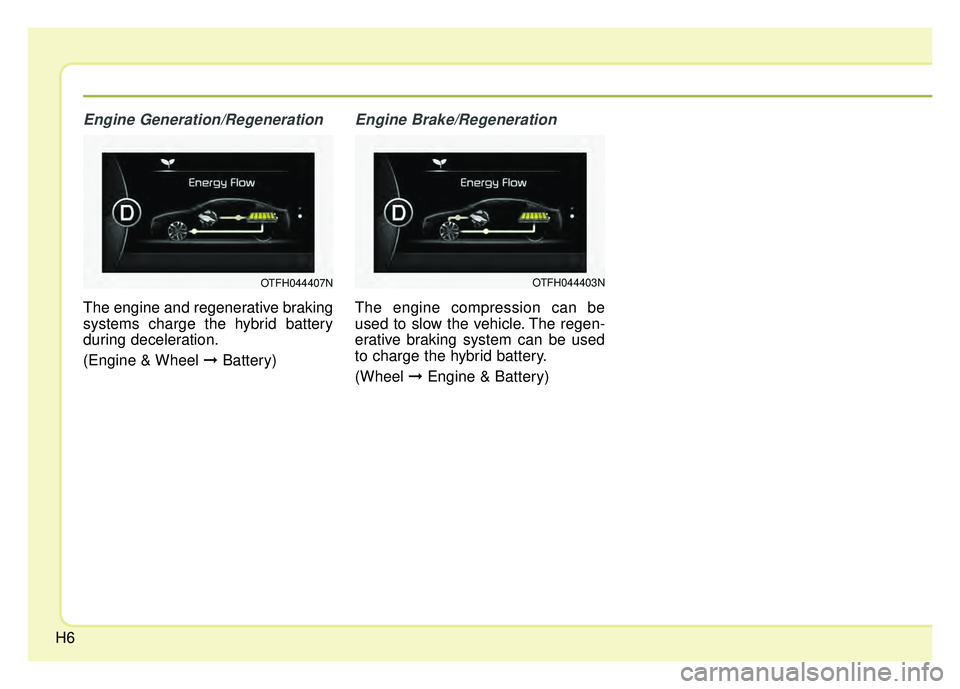
H6
Engine Generation/Regeneration
The engine and regenerative braking
systems charge the hybrid battery
during deceleration.
(Engine & Wheel ➞Battery)
Engine Brake/Regeneration
The engine compression can be
used to slow the vehicle. The regen-
erative braking system can be used
to charge the hybrid battery.
(Wheel ➞Engine & Battery)
OTFH044407NOTFH044403N
Page 13 of 495
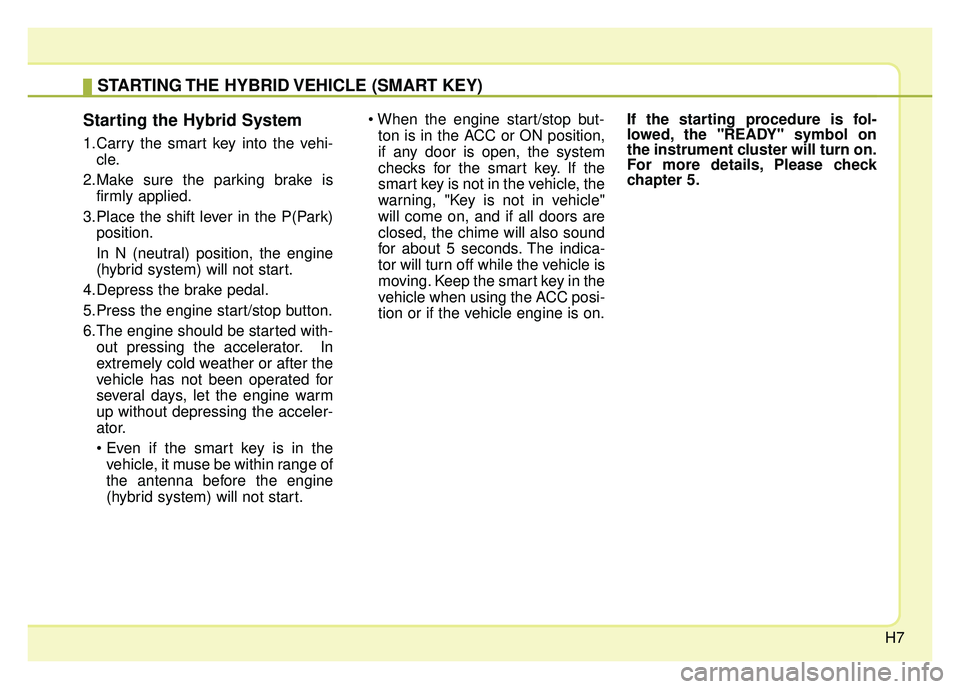
H7
Starting the Hybrid System
1.Carry the smart key into the vehi-cle.
2.Make sure the parking brake is firmly applied.
3.Place the shift lever in the P(Park) position.
In N (neutral) position, the engine
(hybrid system) will not start.
4.Depress the brake pedal.
5.Press the engine start/stop button.
6.The engine should be started with- out pressing the accelerator. In
extremely cold weather or after the
vehicle has not been operated for
several days, let the engine warm
up without depressing the acceler-
ator.
• Even if the smart key is in thevehicle, it muse be within range of
the antenna before the engine
(hybrid system) will not start.
ton is in the ACC or ON position,
if any door is open, the system
checks for the smart key. If the
smart key is not in the vehicle, the
warning, "Key is not in vehicle"
will come on, and if all doors are
closed, the chime will also sound
for about 5 seconds. The indica-
tor will turn off while the vehicle is
moving. Keep the smart key in the
vehicle when using the ACC posi-
tion or if the vehicle engine is on. If the starting procedure is fol-
lowed, the "READY" symbol on
the instrument cluster will turn on.
For more details, Please check
chapter 5.
STARTING THE HYBRID VEHICLE (SMART KEY)
Page 14 of 495
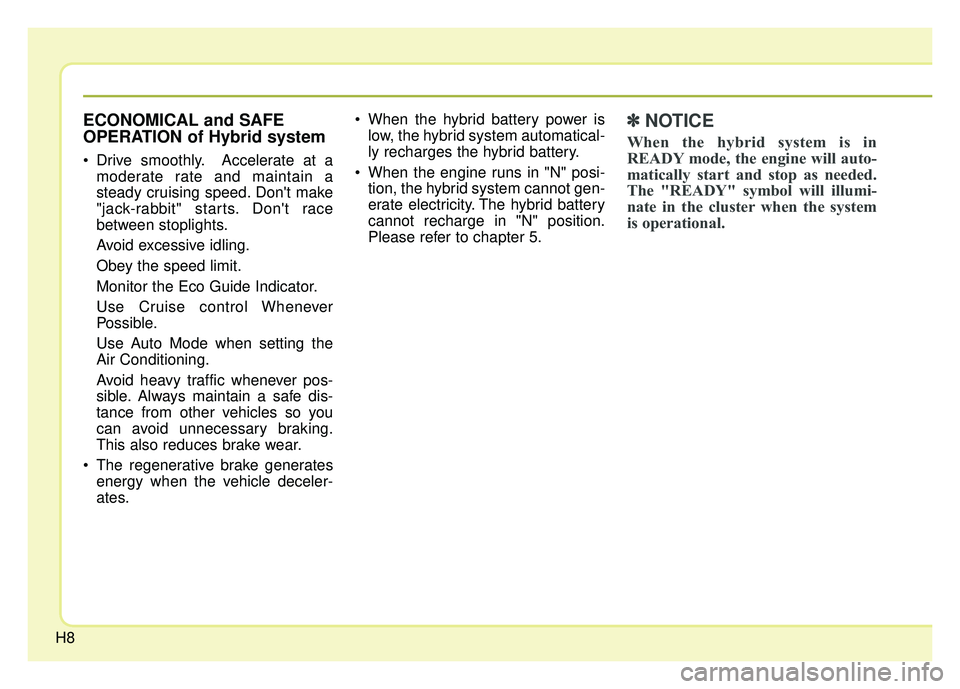
H8
ECONOMICAL and SAFE
OPERATION of Hybrid system
Drive smoothly. Accelerate at amoderate rate and maintain a
steady cruising speed. Don't make
"jack-rabbit" starts. Don't race
between stoplights.
Avoid excessive idling.
Obey the speed limit.
Monitor the Eco Guide Indicator.
Use Cruise control Whenever
Possible.
Use Auto Mode when setting the
Air Conditioning.
Avoid heavy traffic whenever pos-
sible. Always maintain a safe dis-
tance from other vehicles so you
can avoid unnecessary braking.
This also reduces brake wear.
The regenerative brake generates energy when the vehicle deceler-
ates. When the hybrid battery power is
low, the hybrid system automatical-
ly recharges the hybrid battery.
When the engine runs in "N" posi- tion, the hybrid system cannot gen-
erate electricity. The hybrid battery
cannot recharge in "N" position.
Please refer to chapter 5.
✽ ✽ NOTICE
When the hybrid system is in
READY mode, the engine will auto-
matically start and stop as needed.
The "READY" symbol will illumi-
nate in the cluster when the system
is operational.
Page 15 of 495
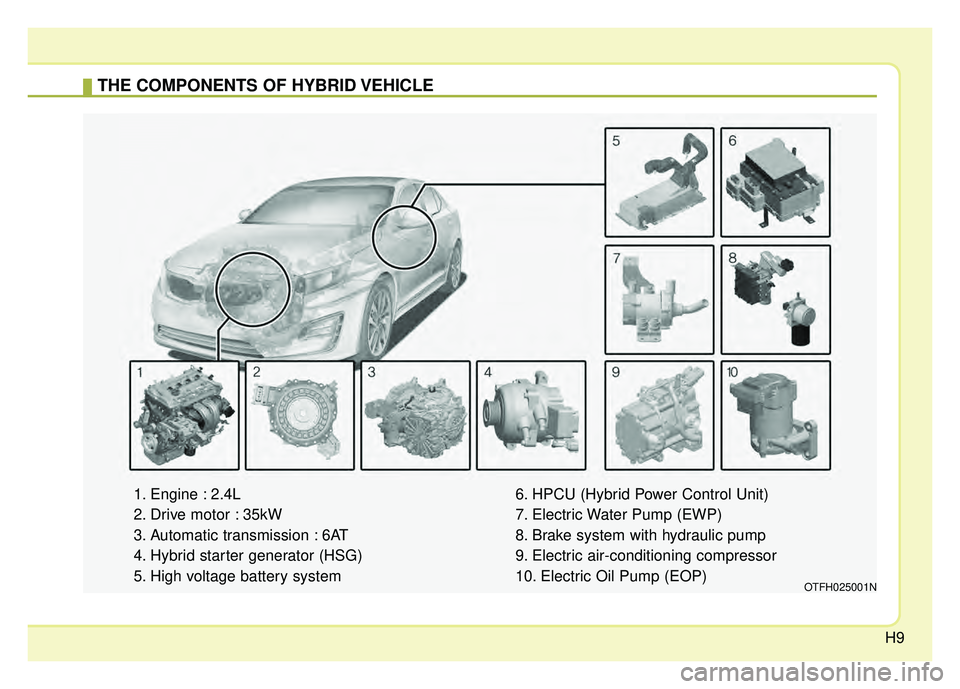
H9
THE COMPONENTS OF HYBRID VEHICLE
1. Engine : 2.4L
2. Drive motor : 35kW
3. Automatic transmission : 6AT
4. Hybrid starter generator (HSG)
5. High voltage battery system6. HPCU (Hybrid Power Control Unit)
7. Electric Water Pump (EWP)
8. Brake system with hydraulic pump
9. Electric air-conditioning compressor
10. Electric Oil Pump (EOP)
OTFH025001N
Page 19 of 495
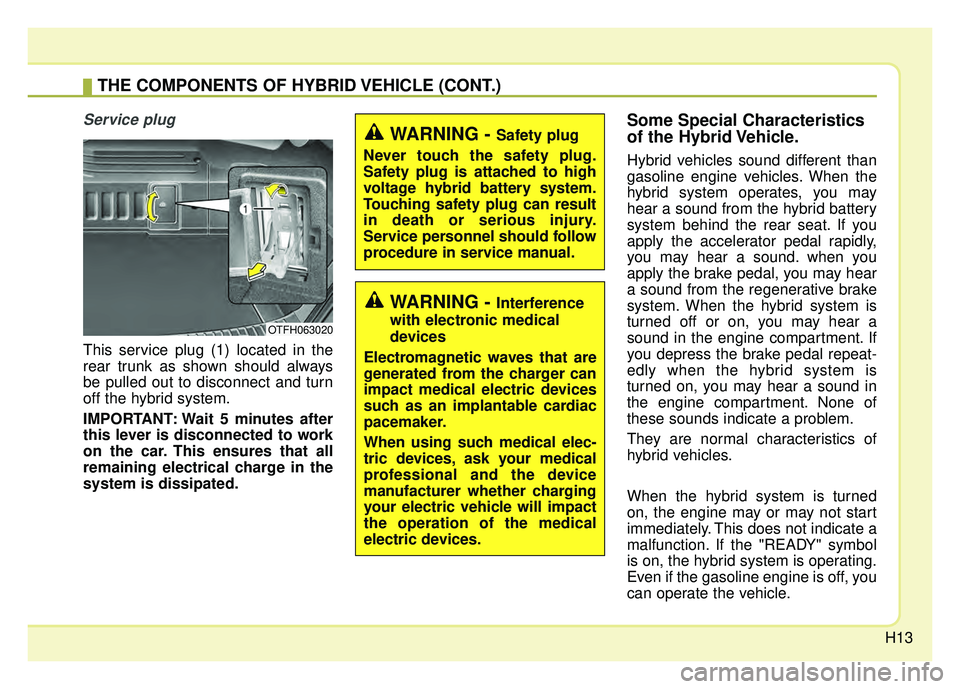
H13
Service plug
This service plug (1) located in the
rear trunk as shown should always
be pulled out to disconnect and turn
off the hybrid system.
IMPORTANT: Wait 5 minutes after
this lever is disconnected to work
on the car. This ensures that all
remaining electrical charge in the
system is dissipated.
Some Special Characteristics
of the Hybrid Vehicle.
Hybrid vehicles sound different than
gasoline engine vehicles. When the
hybrid system operates, you may
hear a sound from the hybrid battery
system behind the rear seat. If you
apply the accelerator pedal rapidly,
you may hear a sound. when you
apply the brake pedal, you may hear
a sound from the regenerative brake
system. When the hybrid system is
turned off or on, you may hear a
sound in the engine compartment. If
you depress the brake pedal repeat-
edly when the hybrid system is
turned on, you may hear a sound in
the engine compartment. None of
these sounds indicate a problem.
They are normal characteristics of
hybrid vehicles.
When the hybrid system is turned
on, the engine may or may not start
immediately. This does not indicate a
malfunction. If the "READY" symbol
is on, the hybrid system is operating.
Even if the gasoline engine is off, you
can operate the vehicle.
OTFH063020
THE COMPONENTS OF HYBRID VEHICLE (CONT.)
WARNING - Safety plug
Never touch the safety plug.
Safety plug is attached to high
voltage hybrid battery system.
Touching safety plug can result
in death or serious injury.
Service personnel should follow
procedure in service manual.
WARNING - Interference
with electronic medical
devices
Electromagnetic waves that are
generated from the charger can
impact medical electric devices
such as an implantable cardiac
pacemaker.
When using such medical elec-
tric devices, ask your medical
professional and the device
manufacturer whether charging
your electric vehicle will impact
the operation of the medical
electric devices.
Page 22 of 495
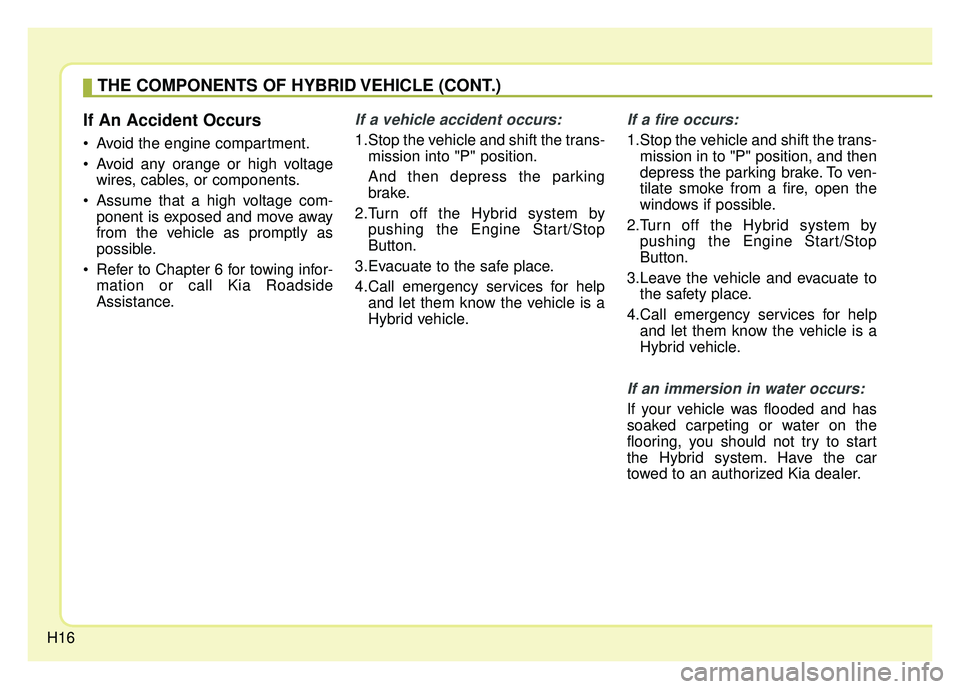
H16
If An Accident Occurs
Avoid the engine compartment.
Avoid any orange or high voltagewires, cables, or components.
Assume that a high voltage com- ponent is exposed and move away
from the vehicle as promptly as
possible.
Refer to Chapter 6 for towing infor- mation or call Kia Roadside
Assistance.
If a vehicle accident occurs:
1.Stop the vehicle and shift the trans-mission into "P" position.
And then depress the parking
brake.
2.Turn off the Hybrid system by pushing the Engine Start/Stop
Button.
3.Evacuate to the safe place.
4.Call emergency services for help and let them know the vehicle is a
Hybrid vehicle.
If a fire occurs:
1.Stop the vehicle and shift the trans-mission in to "P" position, and then
depress the parking brake. To ven-
tilate smoke from a fire, open the
windows if possible.
2.Turn off the Hybrid system by pushing the Engine Start/Stop
Button.
3.Leave the vehicle and evacuate to the safety place.
4.Call emergency services for help and let them know the vehicle is a
Hybrid vehicle.
If an immersion in water occurs:
If your vehicle was flooded and has
soaked carpeting or water on the
flooring, you should not try to start
the Hybrid system. Have the car
towed to an authorized Kia dealer.
THE COMPONENTS OF HYBRID VEHICLE (CONT.)
Page 23 of 495
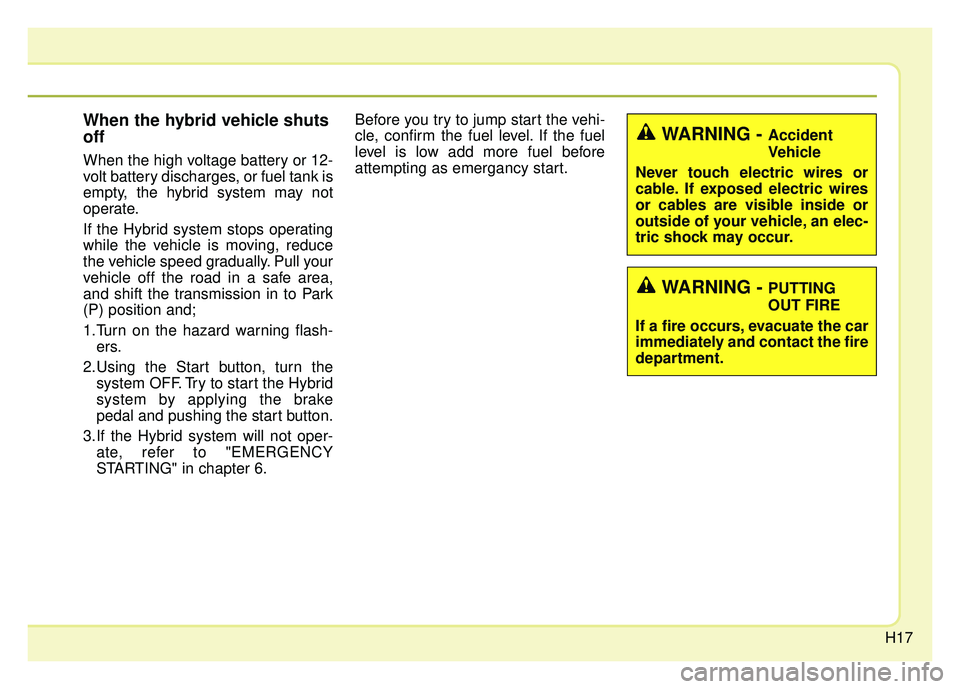
H17
When the hybrid vehicle shuts
off
When the high voltage battery or 12-
volt battery discharges, or fuel tank is
empty, the hybrid system may not
operate.
If the Hybrid system stops operating
while the vehicle is moving, reduce
the vehicle speed gradually. Pull your
vehicle off the road in a safe area,
and shift the transmission in to Park
(P) position and;
1.Turn on the hazard warning flash-ers.
2.Using the Start button, turn the system OFF. Try to start the Hybrid
system by applying the brake
pedal and pushing the start button.
3.If the Hybrid system will not oper- ate, refer to "EMERGENCY
STARTING" in chapter 6. Before you try to jump start the vehi-
cle, confirm the fuel level. If the fuel
level is low add more fuel before
attempting as emergancy start.
WARNING - Accident
Vehicle
Never touch electric wires or
cable. If exposed electric wires
or cables are visible inside or
outside of your vehicle, an elec-
tric shock may occur.
WARNING - PUTTING
OUT FIRE
If a fire occurs, evacuate the car
immediately and contact the fire
department.
Page 27 of 495
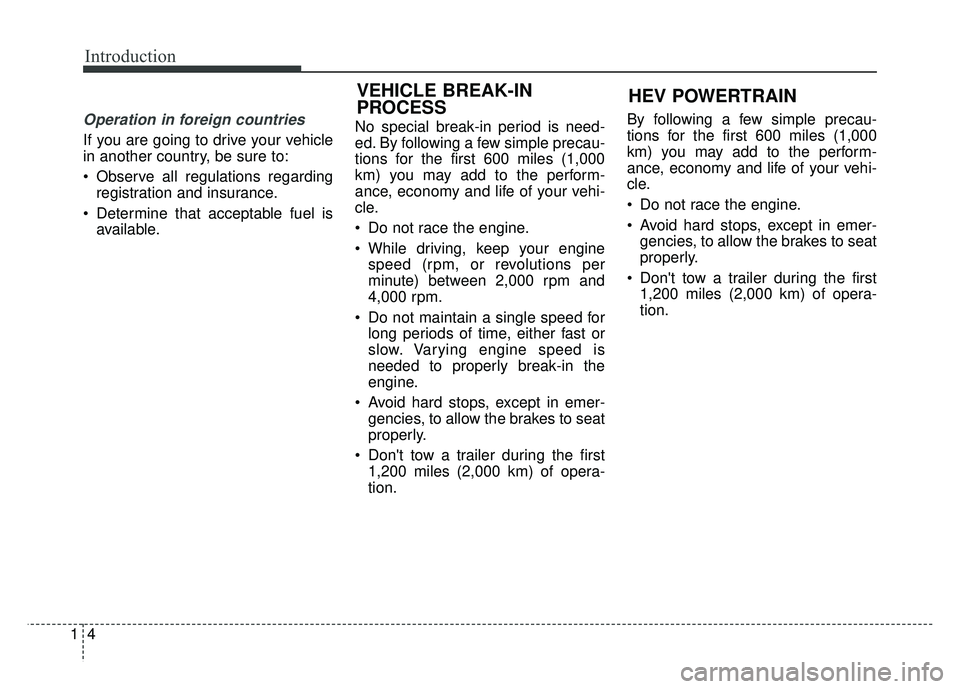
Introduction
41
Operation in foreign countries
If you are going to drive your vehicle
in another country, be sure to:
Observe all regulations regardingregistration and insurance.
Determine that acceptable fuel is available. No special break-in period is need-
ed. By following a few simple precau-
tions for the first 600 miles (1,000
km) you may add to the perform-
ance, economy and life of your vehi-
cle.
Do not race the engine.
While driving, keep your engine
speed (rpm, or revolutions per
minute) between 2,000 rpm and
4,000 rpm.
Do not maintain a single speed for long periods of time, either fast or
slow. Varying engine speed is
needed to properly break-in the
engine.
Avoid hard stops, except in emer- gencies, to allow the brakes to seat
properly.
Don't tow a trailer during the first 1,200 miles (2,000 km) of opera-
tion. By following a few simple precau-
tions for the first 600 miles (1,000
km) you may add to the perform-
ance, economy and life of your vehi-
cle.
Do not race the engine.
Avoid hard stops, except in emer-
gencies, to allow the brakes to seat
properly.
Don't tow a trailer during the first 1,200 miles (2,000 km) of opera-
tion.
VEHICLE BREAK-IN
PROCESS HEV POWERTRAIN